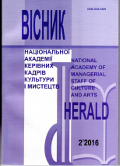MYTHOLOGICAL CODES AND «DOUBLE CODING» IN ART
MYTHOLOGICAL CODES AND «DOUBLE CODING» IN ART
Author(s): Olena AphoninaSubject(s): Theatre, Dance, Performing Arts, Customs / Folklore, Semiology, Ethics / Practical Philosophy, Cultural Anthropology / Ethnology
Published by: Національна академія керівних кадрів культури і мистецтв
Keywords: code; double coding; myth; mythological code; ballet; music; visual arts; theater;
Summary/Abstract: The purpose of the research is to determine the characteristics of mythological code and "double coding" in various art forms. The research methodology is the use of a systematic approach, which reveals features of mythological codes and the "double coding" in different genres of art. The methodological basis for the study of mythological codes is the concept of Peirce and Saussure, and the principles of "double coding" of R. Barth, Charles Jenks and Lotman. Scientific originality. Based on the study of works of various arts, myths are considered as a system of codes. "Double coding" is revealed in the disclosure of double standards of mythological codes and combination of various codes in one piece of work. Conclusions. Mythological codes are presented in all the arts (dance, music, theater and visual arts). Mythological codes maintain a constant system of quality, by which they are differentiated regardless of interpretation of images and stories. M. Tcherepnin's "Narcissus and Echo" demythologizes the true myth content by means of the art of ballet. Remythologization (replacement of old ideas with new ones) is present in "Pygmalion" by B. Shaw. The allusion to the myth of Ariadne is found in the ballet "Crossroads" by R.Poklitaru.
Journal: Вісник Національної академії керівних кадрів культури і мистецтв
- Issue Year: 2016
- Issue No: 2
- Page Range: 76-80
- Page Count: 5
- Language: English

